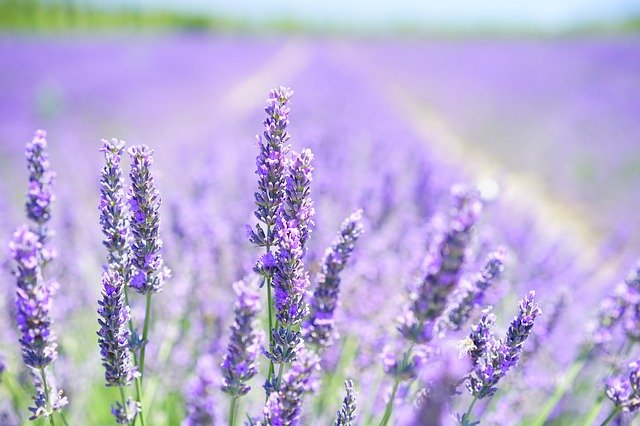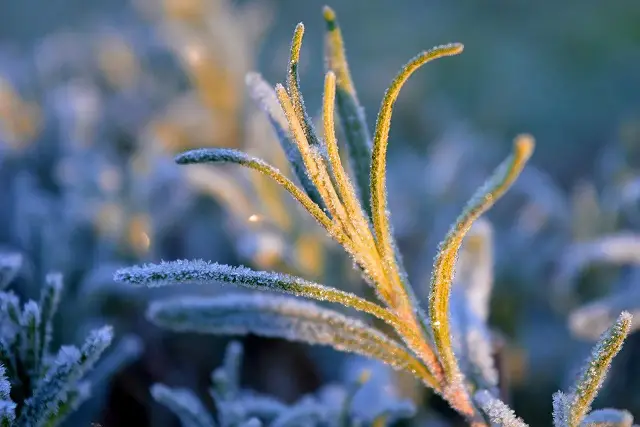Throughout summer and spring lavender blooms and grows to make an appealing sight and smell in the garden. But before you know it, winter is around the corner. Can lavender survive winter?
Only English lavender can survive the winter outdoors. French and hybrid lavenders should be brought indoors in pots for them to survive.
Factors leading to this are:
- Temperatures outside are too low for lavenders to survive
- The soil becomes saturated with moisture and so is the air
- There is not a lot of sunlight in winter
- Young lavenders or lavenders that lack pruning are very vulnerable to cold and moisture
Preparing Your Lavender To Survive Winter
Winters are tough and failure to prepare your lavender could very well lead to death with no chances of survival.
You will have to go above and beyond to make conditions bearable for plants to outlast the cold season.
To give your lavender the best chances of surviving winter and shooting in spring, follow the following tips. Make sure to strictly follow them or else your plant won’t do very well!
a. Bringing Lavender Indoors
If you know that winter is approaching but you really want to grow lavender, you can bring it indoors.
Tip: It is best to choose a smaller and shorter lavender variant so you can adjust it inside. French lavender variants are one of the best options.
But even indoors, there are certain conditions that must be controlled if you want your plant to last till summer.
Make sure the pot plant is on or near a window that receives lots of sunlight. Keep it away from drafts of air and heaters as this dries out the pot faster.
Water the plant only when the first inch of the soil is dry and crumbly. Take care during watering since lavender pot plants are increasingly at risk of developing root rot in winter.
b. Slowing Down Watering
During the regular growing season in summer, the air is hot and warm breezes of air surround the plants.
Meaning that any excess moisture will be removed before it can accumulate and saturate the soil.
Even in their natural environment (Mediterranean conditions), lavender is quite fine with irregular watering. Water the plants once every 2 weeks.
Only exceed this watering limit if there are serious drought conditions during the growing season.
Also note, that not much growth (if any) will occur during winter so the lavender plant requires less water. But this is no reason to stop watering it forever!
c. Pruning
In a way, yearly lavender plant pruning will contribute to helping a lavender plant survive winters.
It does so by delaying the natural process of stems becoming woody progressively with time.
Pruning in late summer or early spring prevents rapid hardening of stems. This process is also necessary since flowers arise from new shoots. But if stems are hard and woody, stems will not develop.
Plus, these woody stems are not hardy and will split open due to water damage (snow, and ice occurring in winter). Once a stem turns woody and gets damaged, the effects are irreversible.
To sum up, the benefits of pruning lavender include:
- Preventing stems from becoming woody, and splitting open. Avoiding this helps them to hold their shape
- Pruning promotes the growth of new stems and this stimulates more flowering
- Altogether, carrying out regular pruning will prolong the life of your lavender plant
During pruning, ⅓ of the lavender’s soft green growth is removed. Then the remaining lavender plant should be cut into a good compact shape till it regrows.
d. Don’t Fertilize Lavender In Winter!
Overly fertile soil will not help a lavender plant survive winter! Although in summer it does stimulate leggy growth instead of flowers.
This will not do much for your plant that is trying to survive, not grow.
Conditions are not adequate enough for growth and you should wait till winter ends to stimulate growth. Instead, focus on keeping the plant dry and try getting sunlight to carry on food synthesis for survival.
So, adding organic fertilizer or chemical fertilizers to lavender plants during winter is not an advisable idea.

Caring For Outdoor Lavender During Winter
Only English lavender has a chance to survive cold winters. But even then you have to do your part to make them comfortable enough to last the harsh conditions.
One principle you can follow to make sure everything is fine is the “ARID” principle.
ARID stands for airflow, rich soil, insulation, and drainage.
Each of these factors is important for lavender to make it through winters and cold climates countries. Follow these to help your plants.
A (Airflow)
Growing lavender plants very close together will not help them stay warm and survive winter! In fact, it could kill them.
Regardless of climatic conditions, lavender plants must have a 2 to 3 feet distance between them.
R (Rich Soil)
By rich soil, we don’t mean soil that has too many nutrients.
Instead, it should have a low to medium nutrient level. Also, the pH should be mildly alkaline or neutral (pH 7). Acidic soil will kill your lavender plants!
I (Insulation)
If you can’t insulate your lavender, make efforts to bring it indoors where it can be sheltered from winter.
This is especially important for the weaker lavender variants that are not winter-hardy. English lavender is resistant to snow, ice, and cold winter weather.
D (Drainage)
In winters, reduce the amount of water you give your lavender plants. Since the air is not as hot, water does not evaporate that easily.
Overwatering could leave the soil saturated with water. Excessive water in the soil can induce root rot in lavender plants, especially while they are dormant in the winter months.
Caring For Indoor Lavender During Winter
Have a weaker or less cold tolerable lavender variant? Bringing it indoors is its best and perhaps only shot of overwintering.
Bringing them into the house doesn’t automatically guarantee a healthy lavender plant.
The only silver lining about bringing lavender indoors is the fact that it never gets cold enough to kill the plant!
As a result, there are a few conditions that should be changed to comfort your plant. They are:
1. Light
Lavender cannot grow without light Normally they grow out in the open with at least 6 hours of light shining over them.
Even if lavender plants are being housed indoors they need the sun or some form of light.
Put them on the window-sill that sees the most sun throughout the day. We understand that bright intense sunlight will be lacking during the winter months.
You might want to look into an artificial grow-light to compensate for the lack of natural light. This will suffice to see as the plants are not really growing.
2. Temperature
Originating from Mediterranean conditions, lavenders usually grow at an average temperature of 68-86°F (20-30°C). In summers lavenders prefer hot temperatures and dry air.
But, during winter the opposite of these conditions is what your lavender plants should be given. Temperatures should be cool as higher temperatures will dry out the plant faster.
The temperature at night can drop to 40°F (5°C) and daytime temperature should not be warmer than 65°F (18°C). Placement also affects the temperature of your pot plant. Avoid keeping it near heaters as this is too hot.
Open windows will create a chilly temperature that is not desirable.
3. Watering
The watering habits need adjustment because of the change in temperature, sun intensity, and season.
Lavender doesn’t need much water during the growing season to start off. When winters approach, they require even less water.
So if you regularly use a watering schedule of every two weeks, this has to be increased to accommodate winter weather.
Lavender is not a prolific grower during the cold season and so watering should be greatly reduced!
Instead of having a strict watering routine, you should use your judgment for watering. Always test the soil before watering the lavender plant.
If it is wet or damp, do not water the plant!
Lavender’s Temperature Tolerance In Winter
In order to correctly measure your lavender’s temperature tolerance in winter, you must identify it correctly.
Then you will be able to know up to what temperature your lavender can tolerate.
– English lavenders
This variant of lavender is the most-hardy being able to survive up to USDA zone 8. It lasts in temperatures up to -20°F (-29°C).
But, English lavender can tolerate a few degrees lower than these values when they have a layer of insulation.
Insulating your lavender can be a help when you want your lavender to overwinter.
– Lavandula x intermedia
Although English lavenders are always the most hardy variants, some hybrid lavenders handle winter quite well!
One particular example of hardy hybrid lavender is the Grosso lavender species. It survives a temperature of -9°F (-23°C) which is quite impressive!
– French Lavender
The French lavender variant is not as hardy as the English variant, it can grow in USDA zones 7-9.
This means the coldest temperature they can survive in is 10°F (-12°C). This is not as good as other lavender variants, plus these lavenders cannot last in snow and icy conditions.
What Does Lavender Look Like In Winter?
Like all plants, lavender looks a certain way in winter because it is a phase of dormancy. No growth will occur during winter and you will not be seeing any green bits or flowers!
All lavender plants will lose their leaves and flowers during winter. This leaves them looking very bare!
The whole plant itself appears as a dry and woody structure that almost looks dead! The stems may not even look alive and you will have to stop yourself from pulling it out!
Lavender is not the most appealing plant in the yard in winter. But, the wait is worthwhile when they flower in summer/spring.
Conclusion
With a few customizations, English lavender survives winter outdoors. But, the same can’t be said about French lavenders and most hybrid lavenders.
An alternative option to help these lavender plants survive is to bring them indoors.
While caring for indoor lavender be sure to take a look at how often to water lavender. Also, temperature and sunlight are two important factors that need to be controlled for the best results.
If all the conditions are acceptable your lavender will survive to see spring and summer. You will get to see flowers and smell lavender!
FAQs
Yes, lavender can survive winter in pots as long as the pots are kept indoors in the case of French and Hybrid lavender.
English lavender is hardier to cold than any other lavender. But if you plant it in a pot, take care of it to make sure it does not dry out or lacks enough sunlight.
Lavender can turn brown, yellow, or gray depending on the environmental conditions or any infection/disease it is facing. This does not necessarily mean that your lavender is dead! Most times the conditions are reversible with enough care.


